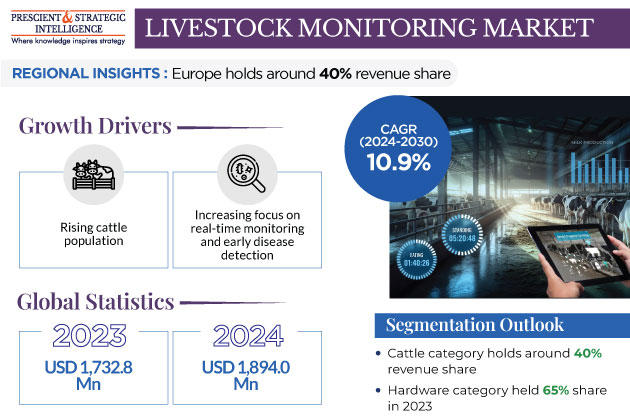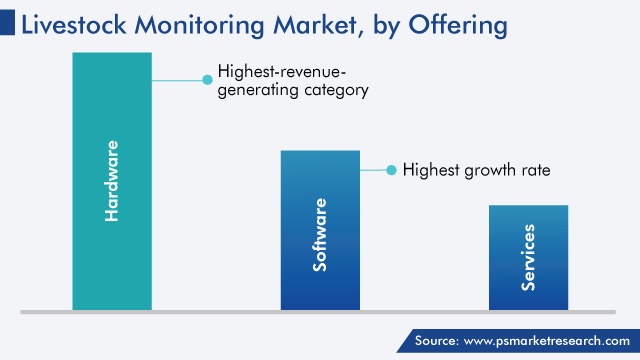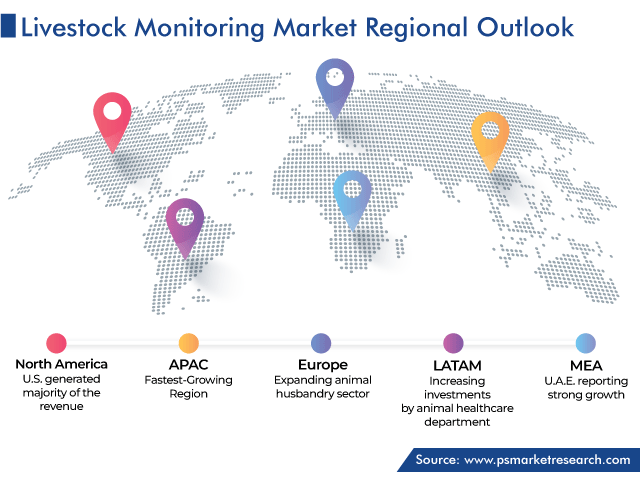Report Code: 12890 | Available Format: PDF | Pages: 350
Livestock Monitoring Market Size and Share Analysis by Offering (Hardware, Software, Services), Livestock Type (Cattle, Poultry, Swine, Equine), Application (Milk Harvesting Management, Heat Detection and Monitoring, Feeding Management, Heat Stress Management, Health Monitoring, Sorting and Weighing Management) - Global Industry Revenue Estimation and Demand Forecast to 2030
- Report Code: 12890
- Available Format: PDF
- Pages: 350
- Report Description
- Table of Contents
- Market Segmentation
- Request Free Sample
Livestock Monitoring Market Outlook
The global livestock monitoring market generated revenue of USD 1,732.8 million in 2023, which is expected to reach USD 3,517.7 million by 2030, witnessing a CAGR of 10.9% during the forecast period. The growth of the market can be attributed to the rise in cattle population, coupled with the growing adoption of technology to monitor their health, behavior, and whereabouts. Moreover, the increasing focus on real-time monitoring and early detection of diseases, surging demand for meat globally, and growing adoption of AI and IoT for livestock monitoring drive the market.

- These monitoring systems are gaining popularity because of the substantial cost-saving associated with them, growing concerns over food security, and increasing number of people engaged in animal husbandry.
- The growing adoption of sensor-based technology will make increasing amounts of information on animals and their environment available, thereby driving the deployment of such technologies for tracking their production, growth, and health.
A significant rise in the prevalence of animal-transmitted diseases globally in recent years has increased the need for animal tracking solutions. With these, farmers are able to check the health of their animals and quickly treat and stop the spread of fatal diseases. Furthermore, the initiatives of governments encouraging animal traceability measures drive the adoption of injectable tags, neck/collar tags, RFID tags, and other pieces of hardware for monitoring cattle.
Rising Focus on Real-Time Monitoring and Early Disease Detection
The rising focus on early disease diagnosis and real-time monitoring of livestock is the significant factor driving the growth of the livestock monitoring market.
- The focus on real-time monitoring and early disease diagnosis is crucial for providing proper care to the animals and helping maintain their health.
- The advancements in sensor technology have enabled farmers to diagnose diseases in animals at the earliest with the help of real-time health status tracking and monitoring.
- With these solutions, any health issue can be ascertained before it worsens, so that it can be rectified as early as possible via the necessary actions.
Moreover, the rise in the adoption of advanced sensor technologies to reduce the cost incurred for livestock monitoring makes these solutions popular. These technologies not only help farmers in collecting real-time data related to the animals’ health but also enable the detection of general behavior, feeding patterns, food and water quality, hygiene levels, biosecurity, and other aspects and aid in identifying, tracking, and tracing herd members accurately. The sensors and smart tags attached to the animals provide information in real time, thereby enabling livestock farmers take corrective and preventive actions. Essentially, the availability of such instruments at low rates drives the demand for advanced monitoring systems for livestock members.
For instance, monitoring animals' rumination patterns is ideal for dairy farmers as it allows them to detect diseases early, so that an effective treatment and recovery plan can be put to action. It also provides indications of whether cattle are distressed or in heat and can help evaluate the most-effective feeding management strategy.
Rising Implementation of AI and IoT for Livestock Monitoring
The IoT technology could play a crucial role in advancing the livestock & farming industry.
- IoT-based technologies and mobile applications are being used for livestock monitoring to increase operational performance, optimize returns, and reduce losses.
- This is achieved by gathering data on the cattle in real time, performing data analytics, and putting in place control mechanisms.
- Moreover, machine learning algorithms and logic are an essential part of precision livestock farming.
- Farmers utilize them to streamline the monitoring of animal behavior, predict disease onset, and optimize the feeding schedule.
Moreover, connected sensors and wearables integrated with AI can track the heart rate, digestion, blood pressure, temperature, respiration rate, and other vitals, which could allow farmers to detect illnesses at the initial stages. Overall, the combination of IoT and AI would help livestock farmers improve their production and keep beef and dairy cows, pigs, goats and sheep, and other animals healthy. Furthermore, the GPS-enabled devices help farmers to trace and locate the grazing herd. Additionally, IoT sensors give clarifications on whether the animal is sick, thus enabling the optimization of grazing patterns.
| Report Attribute | Details |
Market Size in 2023 |
USD 1,732.8 Million |
Market Size in 2024 |
USD 1,894.0 Million |
Revenue Forecast in 2030 |
USD 3,517.7 Million |
Growth Rate |
10.9% CAGR |
Historical Years |
2017-2023 |
Forecast Years |
2024-2030 |
Report Scope |
Market Trends, Drivers, and Restraints; Revenue Estimation and Forecast; Segmentation Analysis; Impact of COVID-19; Companies’ Strategic Developments; Market Share Analysis of Key Players; Company Profiling |
Segments Covered |
By Animal Type; By Offering; By Application; By Region |
Explore more about this report - Request free sample
Cattle Category Dominated Market
The cattle category held the largest revenue share, of 40%, in 2023, and it is further expected to maintain its dominance in the coming years.
- This is owing to the obvious benefits of the implementation of monitoring systems for livestock.
- The good health and wellbeing of animals are essential to dairy farms seeking to achieve sustainability in the production of milk.
- Keeping up to date on the health status of cows is essential for dairy production because milk and other dairy products are imported around the world; many countries have stringent regulations on food safety.
Moreover, the increase in the consumption of beef is a significant factor making the category strong in this market. This is because beef and dairy products are always under supervision by public and private organization as well as governments, to ensure safety and quality, with the ultimate aim to reduce the prevention and transmission of diseases.
The poultry category is expected to witness considerable growth during the forecast period, owing to the high consumption of poultry products in daily life. Additionally, the growing consumer awareness regarding the quality of poultry products has increased the demand for the routine monitoring of animal health.
Hardware Category Held Largest Revenue Share
Hardware category held the largest share, of 65%, in 2023, and it is further expected to maintain its dominance in the future.
- Numerous pieces of hardware are being used to enhance the productivity of the farming trade and reduce the challenges faced by farmers, thus boosting production.
- These instruments do not cause any harm to the animal or the environment.
- The sensors are mainly utilized to keep track of animal health, chewing patterns, and location, for pasture management, and many other processes intrinsic to animal husbandry.
Further, the software category is expected to register the highest CAGR, of 12%, in the forecast period. The usage of software is increasing to monitor animals’ health with an app-based approach. These applications have user-friendly interfaces and advanced features. Such software is being launched by several businesses to make collecting livestock data easier than ever. For instance, in December 2020, Dublin-based company Ever.Ag Corporation launched ALUS Behavior, a technology that monitors the behavior of the herd in the pen round the clock, for a complete behavioral analysis. The goal is to ensure that animals are displaying optimal behavioral patterns, which is indicative of sound health.

APAC Is Fastest-Growing Contributor
Geographically, APAC is expected to see the highest CAGR over the forecast period. This will be due to the large herds of livestock in the region.
- Moreover, the changing dietary patterns, growing population, and rapid urbanization in the region have led to an increase in the consumption of food obtained from animal sources.
- In addition, the region has been consistently ahead in global livestock production, which is expected to continue to rise in the future.
- Additionally, Asia is the largest meat producer across the globe.
Moreover, the regional market is growing due to the government mandates for food quality and interstate livestock trading rules. The region’s milk and cattle farmers are utilizing advanced technologies to cater to the demand for fast-moving dairy and meat products. Moreover, Asian livestock farmers are choosing advanced technologies to increase animal tracking activities in nations like Australia and India. Additionally, the expansion in the population has put a lot of pressure on farmers in developing nations, such as South Korea, India, and China, to be productive and successful. As a result, advanced techniques and solutions have been launched to allow for the production of better animal cow products.

Europe held the largest revenue share for the livestock monitoring market.
- This is owing to the expanding animal husbandry sector, along with the rising adoption of advanced automated systems for the real-time monitoring of livestock.
- Moreover, the European Commission is implementing several policies and subsidies for livestock farmers, to enhance productivity and control disease outbreaks in the region.
- Further, the rising demand for animal-sourced food products, such as meat, eggs, and milk, is propelling the need for efficient and cost-effective livestock management systems.
Top Providers of Livestock Monitoring Solutions Are:
- Afimilk Agricultural Cooperative Ltd.
- Dairymaster
- CowManager BV
- Merck & Co. Inc.
- BouMatic LLC
- Nedap N.V.
- GEA Group Aktiengesellschaft
- Lely International N.V.
- DeLaval
- Fancom BV
Market Size Breakdown by Segment
This report offers deep insights into the livestock monitoring market, with size estimation for 2017 to 2030, the major drivers, restraints, trends and opportunities, and competitor analysis.
Based on Offering
- Hardware
- Software
- Services
Based on Livestock Type
- Cattle
- Poultry
- Swine
- Equine
Based on Application
- Milk Harvesting Management
- Heat Detection and Monitoring
- Feeding Management
- Heat Stress Management
- Health Monitoring
- Sorting and Weighing Management
Region/Countries Reviewed for this Report
- North America
- U.S.
- Canada
- Europe
- Germany
- U.K.
- France
- Italy
- Spain
- Asia-Pacific
- Japan
- China
- India
- South Korea
- Australia
- Latin America
- Brazil
- Mexico
- Middle East and Africa
- Saudi Arabia
- South Africa
- U.A.E.
The global livestock monitoring market will touch a value of USD 3,517.7 million, by 2030.
The CAGR for the global livestock monitoring market in the coming years will be 10.9%, reflecting a steady and robust growth trend.
The livestock monitoring market is driven by factors like increased cattle numbers, tech adoption for health tracking, real-time illness monitoring focus, growing meat demand, and AI/IoT integration in monitoring solutions.
A prominent trend in the livestock monitoring market is the growing focus on early disease diagnostics and real-time monitoring of livestock. This trend underscores the importance of proactive healthcare management for animals, ensuring their well-being and productivity.
The Asia-Pacific region is projected to witness the highest CAGR over the forecast period, attributed to its large livestock herds, changing dietary patterns, population growth, and rapid urbanization leading to increased consumption of animal-derived food.
Want a report tailored exactly to your business strategy?
Request CustomizationWant an insight-rich discussion with the report author?
Speak to AnalystOur dedication to providing the most-accurate market information has earned us verification by Dun & Bradstreet (D&B). We strive for quality checking of the highest level to enable data-driven decision making for you
Our insights into the minutest levels of the markets, including the latest trends and competitive landscape, give you all the answers you need to take your business to new heights
With 24/7 research support, we ensure that the wheels of your business never stop turning. Don’t let time stand in your way. Get all your queries answered with a simple phone call or email, as and when required
We take a cautious approach to protecting your personal and confidential information. Trust is the strongest bond that connects us and our clients, and trust we build by complying with all international and domestic data protection and privacy laws